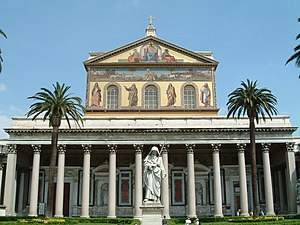

Patriarchate of Alexandria | |
|---|---|
| Bishopric | |
| catholic | |
| Information | |
| Established | 1215 |
| Dissolved | 1964 |
| Cathedral | Basilica of Saint Paul Outside the Walls |
The Latin Patriarchate of Alexandria was a nominal patriarchate of the Latin church on the see of AlexandriainEgypt.[1][2]
Alexandria, the ancient great port of Egypt and a first-rank Mediterranean metropolis in the Hellenistic world, was an influential early Christian diocese. It was founded, according to Church tradition, by Saint Mark the Evangelist. The First Council of Nicaea ranked it after Rome, while the Greek fathers of the Council of Chalcedon tried in canon 28 to demote it, giving it third place after Constantinople, although Pope Leo I of Rome rejected this canon. However, following the same council, the patriarchate was claimed by two parties: a Greek patriarch who adhered to the dogmatic definitions of Chalcedon and a Coptic Miaphysite patriarch who rejected them. The Greek patriarch had little pastoral control over Christians in the patriarchate as most Christians soon accepted the Coptic Church as the true church.
While part of the Byzantine Empire and under Islamic domination, the Chalcedonian patriarch always followed the Byzantine rite, while the non-Chalcedonian patriarch followed the Coptic rite. The Greek patriarch of Alexandria remained in communion with the See of Rome despite the rupture of communion between Rome and Constantinople in 1054. In fact, the bishop of Rome and Greek bishop of Alexandria commemorated each other in their diptychs until the early 14th century.[3] Thus, while in 1215, during the pontificate of Pope Innocent III, there were Latin patriarchs, rivaling or replacing the Greek ones in the formerly Crusader held cities of Antioch, Constantinople, and Jerusalem, Greek Patriarch Mark III of Alexandria was invited and sent representatives to participate in the Fourth Lateran Council.[4]

Records of a Latin patriarch of Alexandria begin only in the 14th century. The position was merely titular since the bishop never occupied the See. His patriarchal cathedral in Rome was the papal Basilica of Saint Paul Outside the Walls. Many incumbents would hold residential (arch)episcopal posts of various ranks in Catholic countries, and even (earlier and/or later) other Titular Latin patriarchates (Jerusalem, Constantinople). The titular see would have its share of disputed nominations during the papal schisminAvignon.
Since 1724, the Melkite Catholic Patriarchate of Antioch and All the East holds the title of patriarch of Alexandria. In 1895, the Coptic Catholic Patriarchate of Alexandria was established out of the Catholic Apostolic Vicariate of Alexandria. Thus, there remains a patriarch of Alexandria for the Catholic Church.
The titular Latin Patriarchate of Alexandria was left vacant in 1954 and suppressed in January 1964 along with those of Antioch and Constantinople. It was no longer mentioned in the Vatican yearbook (rather than being announced as being abolished).[5] This was after Pope Paul VI met with Ecumenical Patriarch Athenagoras I of Constantinople, showing the Latin Church by this point was more interested in reconciliation with the Eastern Church, abolishing the titular title. [6]
|
| |||||||
|---|---|---|---|---|---|---|---|
| Patriarchates (byorder of precedence) |
| ||||||
| History |
| ||||||
| Language |
| ||||||
| Liturgical rites Liturgical days |
| ||||||
| See also |
| ||||||
| |||||||